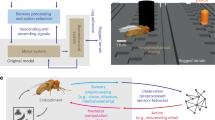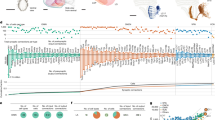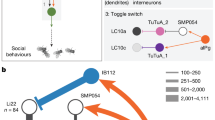Abstract
Neuropsychiatric disorders are of complex etiology, often including a large genetic component. In order to help identify and study the molecular and physiological mechanisms that such genes participate in, numerous animal models have been established in a variety of species. Over the past decade, this has increasingly included the vinegar fly, Drosophila melanogaster. Here, we outline why we study an invertebrate organism in the context of neuropsychiatric disorders, and we discuss how we can gain insight from studies in Drosophila. We focus on a few disorders and findings to make the larger point that modeling these diseases in flies can have both mechanistic and predictive validity. Highlighting some translational examples, we underline the fact that their brains works more like ours than one would have anticipated.
Similar content being viewed by others
Log in or create a free account to read this content
Gain free access to this article, as well as selected content from this journal and more on nature.com
or
References
Adoutte A, Balavoine G, Lartillot N, Lespinet O, Prud'homme B, de Rosa R (2000). The new animal phylogeny: reliability and implications. Proc Natl Acad Sci USA 97: 4453–4456.
Alaerts M, Del-Favero J (2009). Searching genetic risk factors for schizophrenia and bipolar disorder: learn from the past and back to the future. Hum Mutat 30: 1139–1152.
Allada R, Emery P, Takahashi JS, Rosbash M (2001). Stopping time: the genetics of fly and mouse circadian clocks. Annu Rev Neurosci 24: 1091–1119.
Andretic R, Chaney S, Hirsh J (1999). Requirement of circadian genes for cocaine sensitization in Drosophila. Science 285: 1066–1068.
Bear MF, Huber KM, Warren ST (2004). The mGluR theory of fragile X mental retardation. Trends Neurosci 27: 370–377.
Bellen HJ, Tong C, Tsuda H (2010). 100 years of Drosophila research and its impact on vertebrate neuroscience: a history lesson for the future. Nat Rev Neurosci 11: 514–522.
Benzer S (1967). Behavioral mutants of Drosophila isolated by countercurrent distribution. Proc Natl Acad Sci USA 58: 1112–1119.
Callan MA, Zarnescu DC (2011). Heads-up: new roles for the fragile X mental retardation protein in neural stem and progenitor cells. Genesis 49: 424–440.
Chan CC, Scoggin S, Wang D, Cherry S, Dembo T, Greenberg B et al (2011). Systematic discovery of Rab GTPases with synaptic functions in Drosophila. Curr Biol 21: 1704–1715.
Chang S, Bray SM, Li Z, Zarnescu DC, He C, Jin P et al (2008). Identification of small molecules rescuing fragile X syndrome phenotypes in Drosophila. Nat Chem Biol 4: 256–263.
Corl AB, Berger KH, Ophir-Shohat G, Gesch J, Simms JA, Bartlett SE et al (2009). Happyhour, a Ste20 family kinase, implicates EGFR signaling in ethanol-induced behaviors. Cell 137: 949–960.
Devineni AV, Heberlein U (2009). Preferential ethanol consumption in Drosophila models features of addiction. Curr Biol 19: 2126–2132.
Dietzl G, Chen D, Schnorrer F, Su KC, Barinova Y, Fellner M et al (2007). A genome-wide transgenic RNAi library for conditional gene inactivation in Drosophila. Nature 448: 151–156.
Dockendorff TC, Su HS, McBride SM, Yang Z, Choi CH, Siwicki KK et al (2002). Drosophila lacking dfmr1 activity show defects in circadian output and fail to maintain courtship interest. Neuron 34: 973–984.
Edgar BA, Lehner CF (1996). Developmental control of cell cycle regulators: a fly's perspective. Science 274: 1646–1652.
Engel JE, Wu C-F (2009). Neurogenetic approaches to habituation and dishabituation in Drosophila. Neurobiol Learn Mem 92: 166–175.
Gehring WJ, Kloter U, Suga H (2009). Evolution of the Hox gene complex from an evolutionary ground state. Curr Top Dev Biol 88: 35–61.
Ghezzi A, Krishnan HR, Atkinson NS (2012). Susceptibility to ethanol withdrawal seizures is produced by BK channel gene expression. Addict Biol 19: 332–337.
Gratz SJ, Wildonger J, Harrison MM, O'Connor-Giles KM (2013). CRISPR/Cas9-mediated genome engineering and the promise of designer flies on demand. Fly 7: 249–255.
Halder G, Callaerts P, Gehring WJ (1995). Induction of ectopic eyes by targeted expression of the eyeless gene in Drosophila. Science 267: 1788–1792.
Hall JC (1977). Portions of the central nervous system controlling reproductive behavior in Drosophila melanogaster. Behav Genet 7: 291–312.
Hardin PE, Hall JC, Rosbash M (1990). Feedback of the Drosophila period gene product on circadian cycling of its messenger RNA levels. Nature 343: 536–540.
Insel TR, Cuthbert BN (2009). Endophenotypes: bridging genomic complexity and disorder heterogeneity. Biol Psychiatry 66: 988–989.
Iyengar SK, Elston RC (2007). The genetic basis of complex traits: rare variants or "common gene, common disease"? Methods Mol Biol 376: 71–84.
Kaun KR, Azanchi R, Maung Z, Hirsh J, Heberlein U (2011). A Drosophila model for alcohol reward. Nat Neurosci 14: 612–619.
Kaun KR, Devineni AV, Heberlein U (2012). Drosophila melanogaster as a model to study drug addiction. Human Genet 131: 959–975.
Klarsfeld A, Rouyer F (1998). Effects of circadian mutations and LD periodicity on the life span of Drosophila melanogaster. J Biol Rhythms 13: 471–478.
Konopka RJ, Benzer S (1971). Clock mutants of Drosophila melanogaster. Proc Natl Acad Sci USA 68: 2112–2116.
Koob GF (2004). A role for GABA mechanisms in the motivational effects of alcohol. Biochem Pharmacol 68: 1515–1525.
Kramár EA, Lin B, Rex CS, Gall CM, Lynch G (2006). Integrin-driven actin polymerization consolidates long-term potentiation. Proc Natl Acad Sci USA 103: 5579–5584.
Krishnan V, Han M-H, Graham DL, Berton O, Renthal W, Russo SJ et al (2007). Molecular adaptations underlying susceptibility and resistance to social defeat in brain reward regions. Cell 131: 391–404.
Kumar V, Kim K, Joseph C, Thomas LC, Hong H, Takahashi JS (2011). Second-generation high-throughput forward genetic screen in mice to isolate subtle behavioral mutants. Proc Natl Acad Sci USA 108: 15557–15564.
Lawal HO, Terrell A, Lam HA, Djapri C, Jang J, Hadi R et al (2014). Drosophila modifier screens to identify novel neuropsychiatric drugs including aminergic agents for the possible treatment of Parkinson's disease and depression. Mol Psychiatry 19: 235–242.
Lee HG, Kim YC, Dunning JS, Han KA (2008). Recurring ethanol exposure induces disinhibited courtship in Drosophila. PLoS One 3: e1391.
Lloyd TE, Taylor JP (2010). Flightless flies: Drosophila models of neuromuscular disease. Ann NY Acad Sci 1184: e1–e20.
McBride SM, Bell AJ, Jongens TA (2012). Behavior in a Drosophila model of fragile X. Results Prob Cell Differ 54: 83–117.
McBride SM, Choi CH, Wang Y, Liebelt D, Braunstein E, Ferreiro D et al (2005). Pharmacological rescue of synaptic plasticity, courtship behavior, and mushroom body defects in a Drosophila model of fragile X syndrome. Neuron 45: 753–764.
McClung CA (2007). Circadian genes, rhythms and the biology of mood disorders. Pharmacol Ther 114: 222–232.
Mongeluzi DL, Hoppe TA, Frost WN (1998). Prepulse inhibition of the Tritonia escape swim. J Neurosci 18: 8467–8472.
Ojelade SA, Jia T, Rodan AR, Chenyang T, Kadrmas JL, Cattrell A et al (2015). Rsu1 regulates ethanol consumption in Drosophila and humans. Proc Natl Acad Sci USA 112: E4085–E4093.
Penn JK, Zito MF, Kravitz EA (2010). A single social defeat reduces aggression in a highly aggressive strain of Drosophila. Proc Natl Acad Sci USA 107: 12682–12686.
Peru y Colon de Portugal RL, Acevedo SF, Rodan AR, Chang LY, Eaton BA, Rothenfluh A (2012). Adult neuronal Arf6 controls ethanol-induced behavior with Arfaptin downstream of Rac1 and RhoGAP18B. J Neurosci 32: 17706–17713.
Peru y Colon de Portugal RL, Ojelade SA, Penninti PS, Dove RJ, Nye MJ, Acevedo SF et al (2014). Long-lasting, experience-dependent alcohol preference in Drosophila. Addict Biol 19: 392–401.
Peterson KJ, Lyons JB, Nowak KS, Takacs CM, Wargo MJ, McPeek MA (2004). Estimating metazoan divergence times with a molecular clock. Proc Natl Acad Sci USA 101: 6536–6541.
Pohl JB, Ghezzi A, Lew LK, Robles RB, Cormack L, Atkinson NS (2013). Circadian genes differentially affect tolerance to ethanol in Drosophila. Alcohol Clin Exp Res 37: 1862–1871.
Quinn WG, Harris WA, Benzer S (1974). Conditioned behavior in Drosophila melanogaster. Proc Natl Acad Sci USA 71: 708–712.
Reiter LT, Potocki L, Chien S, Gribskov M, Bier E (2001). A systematic analysis of human disease-associated gene sequences in Drosophila melanogaster. Genome Res 11: 1114–1125.
Rodan AR, Kiger JA Jr, Heberlein U (2002). Functional dissection of neuroanatomical loci regulating ethanol sensitivity in Drosophila. J Neurosci 22: 9490–9501.
Rodan AR, Rothenfluh A (2010). The genetics of behavioral alcohol responses in Drosophila. Int Rev Neurobiol 91: 25–51.
Rothenfluh A, Cowan CW (2013). Emerging roles of actin cytoskeleton regulating enzymes in drug addiction: actin or reactin'? Curr Opin Neurobiol 23: 507–512.
Rothenfluh A, Threlkeld RJ, Bainton RJ, Tsai LT, Lasek AW, Heberlein U (2006). Distinct behavioral responses to ethanol are regulated by alternate RhoGAP18B isoforms. Cell 127: 199–211.
Rothenfluh A, Young MW, Saez L (2000). A TIMELESS-independent function for PERIOD proteins in the Drosophila clock. Neuron 26: 505–514.
Rubin GM, Yandell MD, Wortman JR, Gabor Miklos GL, Nelson CR, Hariharan IK et al (2000). Comparative genomics of the eukaryotes. Science 287: 2204–2215.
Sanders SJ, Murtha MT, Gupta AR, Murdoch JD, Raubeson MJ, Willsey AJ et al (2012). De novo mutations revealed by whole-exome sequencing are strongly associated with autism. Nature 485: 237–241.
Sawamura N, Ando T, Maruyama Y, Fujimuro M, Mochizuki H, Honjo K et al (2008). Nuclear DISC1 regulates CRE-mediated gene transcription and sleep homeostasis in the fruit fly. Mol Psychiatry 13: 1138–1148, 1069.
Scholz H, Ramond J, Singh CM, Heberlein U (2000). Functional ethanol tolerance in Drosophila. Neuron 28: 261–271.
Schuckit MA, Smith TL, Kalmijn J (2004). Findings across subgroups regarding the level of response to alcohol as a risk factor for alcohol use disorders: a college population of women and Latinos. Alcohol Clin Exp Res 28: 1499–1508.
Schumann G, Coin LJ, Lourdusamy A, Charoen P, Berger KH, Stacey D et al (2011). Genome-wide association and genetic functional studies identify autism susceptibility candidate 2 gene (AUTS2 in the regulation of alcohol consumption. Proc Natl Acad Sci USA 108: 7119–7124.
Shohat-Ophir G, Kaun KR, Azanchi R, Mohammed H, Heberlein U (2012). Sexual deprivation increases ethanol intake in Drosophila. Science 335: 1351–1355.
Simmons JM, Quinn KJ (2014). The NIMH Research Domain Criteria (RDoC) Project: implications for genetics research. Mamm Genome 25: 23–31.
Spanagel R, Pendyala G, Abarca C, Zghoul T, Sanchis-Segura C, Magnone MC et al (2005). The clock gene Per2 influences the glutamatergic system and modulates alcohol consumption. Nat Med 11: 35–42.
Strausfeld NJ, Hirth F (2013). Deep homology of arthropod central complex and vertebrate basal ganglia. Science 340: 157–161.
Sturtevant A (1967) A History of Genetics. Cold Spring Harbor Laboratory Press: Cold Spring Harbor, NY.
Tandon R, Keshavan MS, Nasrallah HA (2008). Schizophrenia, "just the facts" what we know in 2008. 2. Epidemiology and etiology. Schizophr Res 102: 1–18.
Tauber JM, Vanlandingham PA, Zhang B (2011). Elevated levels of the vesicular monoamine transporter and a novel repetitive behavior in the Drosophila model of fragile X syndrome. PLoS One 6: e27100.
Toh KL, Jones CR, He Y, Eide EJ, Hinz WA, Virshup DM et al (2001). An hPer2 phosphorylation site mutation in familial advanced sleep phase syndrome. Science 291: 1040–1043.
van Alphen B, van Swinderen B (2013). Drosophila strategies to study psychiatric disorders. Brain Res Bull 92: 1–11.
Wolf FW, Rodan AR, Tsai LT, Heberlein U (2002). High-resolution analysis of ethanol-induced locomotor stimulation in Drosophila. J Neurosci 22: 11035–11044.
Yang Z, Bertolucci F, Wolf R, Heisenberg M (2013). Flies cope with uncontrollable stress by learned helplessness. Curr Biol 23: 799–803.
Young MW, Kay SA (2001). Time zones: a comparative genetics of circadian clocks. Nat Rev Genet 2: 702–715.
Zhang YQ, Broadie K (2005). Fathoming fragile X in fruit flies. Trends Genet 21: 37–45.
Acknowledgements
This work was funded by the NIH, R01AA019526 and R21AA022404. We thank Aylin Rodan for critical reading of the manuscript.
Author information
Authors and Affiliations
Corresponding author
PowerPoint slides
Rights and permissions
About this article
Cite this article
Narayanan, A., Rothenfluh, A. I Believe I Can Fly!: Use of Drosophila as a Model Organism in Neuropsychopharmacology Research. Neuropsychopharmacol 41, 1439–1446 (2016). https://doi.org/10.1038/npp.2015.322
Received:
Revised:
Accepted:
Published:
Issue date:
DOI: https://doi.org/10.1038/npp.2015.322
This article is cited by
-
Effects of lithium on aggression in Drosophila
Neuropsychopharmacology (2023)
-
The Arf6 activator Efa6/PSD3 confers regional specificity and modulates ethanol consumption in Drosophila and humans
Molecular Psychiatry (2018)



